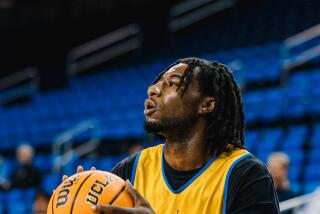How much fun from one-and-done?
Thanks for the memories?
The 31 players who spent only one season in college before becoming first-round NBA draft picks since the league changed its minimum-age requirements in 2005 have produced zero NCAA titles.
Generating headaches for fans, coaches and teammates hasn’t been quite as taxing.
The unexpected departure of Jrue Holiday after one season at UCLA contributed to a rare losing season the following year for the Bruins. USC’s O.J. Mayo sparked a NCAA investigation over improper benefits that led to self-imposed punishments that included a postseason ban and helped nudge coach Tim Floyd out of what he had long proclaimed would be his last job.
Floyd now coaches at Texas El Paso.
But as Floyd often repeated throughout Mayo’s brief stay at USC, which resulted in an NCAA tournament appearance: He hated to think where the Trojans would be without Mayo.
That’s the conundrum of the here-today, gone-tomorrow freshmen from a college coach’s perspective — you might not be able to win basketball’s biggest prize with them, but your record certainly would suffer had they been allowed to go straight to the NBA.
The benefits of so-called one-and-done players seem murkier for the rest of the college community.
“None of these guys are dying to be student-athletes,” said one NBA executive, speaking on condition of anonymity because of the sensitivity of the issue. “If they were, they wouldn’t be leaving for Las Vegas two seconds after their team loses [in the NCAA tournament] to go hang out with some wannabe workout guy to prepare for the draft.
“The guys who want to go to college, let them go to college. The one-and-done guys, all they’re doing is playing for a minor league system under the guise of it being the NCAA.”
NCAA executives and coaches have long professed a desire to follow the baseball model, where players may be drafted out of high school but once they enter college must wait three years to be eligible for the draft again. That doesn’t appear likely to happen any time soon.
According to multiple people around the NBA, the league’s minimum-age guidelines that require players to be at least 19 and one year removed from high school are not expected to be altered in the coming months as part of negotiations for a new collective bargaining agreement.
No freshman has been the focal point of an NCAA champion since Syracuse’s Carmelo Anthony in 2003, and that was two years before the NBA barred players from jumping directly from high school to the league. There have been close calls with Ohio State’s Greg Oden and Mike Conley Jr. reaching the title game in 2007 and Memphis’ Derrick Rose doing the same a year later, though that NCAA tournament run was later vacated when Rose’s SAT score was invalidated.
One possible upside to players leaving after only one year is that it has resulted in increased parity in the college game, allowing mid-majors laden with juniors and seniors such as George Mason, Butler and Virginia Commonwealth to reach basketball’s biggest stage.
“When the high-major teams lose those guys, it allows experienced teams like Butler to make it into the Final Four two years in a row,” said Paul Hewitt, George Mason’s new coach. “As the guys leave, it may hurt an individual program, but it’s brought another level of teams who think they can make a run in March.”
Hewitt knows all too well one of the chief drawbacks of early departures: a short-handed roster. As coach at Georgia Tech, he lost four freshmen to the draft — Chris Bosh, Derrick Favors, Javaris Crittenton and Thaddeus Young — and he acknowledged that his inability to have ready replacements contributed to his firing after last season.
“I think I have to be honest with myself and say I didn’t manage properly for that possibility,” Hewitt said. “I think we lost so many guys that it came back to get us.”
Another concern of the fleeting freshmen is their impact on a program’s Academic Progress Rate, the NCAA point system that can result in loss of scholarships or harsher punishments for teams whose athletes do not perform well in the classroom, particularly if they leave school when they are not in good academic standing.
Ohio State was docked two scholarships after Oden and Kosta Koufos failed to complete the third-quarter term during their one and only college seasons.
“It affects your APR, no question,” said UCLA Coach Ben Howland, who has lost three freshmen to the draft — Trevor Ariza in 2004, Kevin Love in 2008 and Holiday in 2009. Among the three, only Love was part of a deep NCAA tournament run, leading the Bruins to the Final Four.
Though many believe Ariza (a second-round pick) and Holiday (No. 17 overall) could have improved their draft stock by remaining in college for an additional year, Howland maintained their decisions have not had negative long-term implications. Ariza won a title with the Lakers and made $6.3 million last season with New Orleans; Holiday started all 82 games for Philadelphia.
Their departures had bigger consequences for UCLA. The Bruins reached only the first round of the NCAA tournament the season after Ariza left, the second round the season after Love left; and had a losing record the season after Holiday left.
“Obviously, for us it’s been difficult,” Howland said of the exodus. “You don’t know for sure who’s coming, who’s going and how to plan your roster and how to recruit.
“But are we going to stop trying to recruit the best players we can get that fit UCLA both academically as well as athletically and socially? No. We’re going to try to get the best players.”
Some teams have done a better job of bouncing back from early departures than others. Kentucky advanced to the Final Four last season despite losing four freshmen from the previous year’s team.
Nevertheless, Wildcats Coach John Calipari, who through a school spokesman declined to be interviewed for this story, has said he dislikes the NBA’s minimum-age rule. He will lose two more freshmen this year in Brandon Knight and Enes Kanter, who are both projected as top-five draft picks.
“I don’t think it’s good for college; I don’t think it’s good for the NBA,” Calipari said of the rule during the NCAA tournament. “But it’s a rule that we have to live with.
“We’ve lost some players after a year, and we’ve survived. I tell kids, ‘You know, early on I would say if you want to do what’s right for you and your family, you probably should put your name in the draft. If you want to do what’s right for me and my family, why don’t you stay a couple more years so we can win a whole lot more games?’”
Predicting whether freshmen will stay or go in the draft is an inexact science. Kentucky’s Daniel Orton, who averaged only 3.4 points a game, declared last year and was a first-round pick; North Carolina’s Harrison Barnes, who averaged 15.7 points and was the first freshman to become a preseason All-American selection by the Associated Press, has decided to return for a second college season.
USC Coach Kevin O’Neill said too many college freshmen wrongly think they’re ready for the NBA. Former Trojans forward Davon Jefferson went undrafted and ended up playing in Europe. Georgia Tech’s Crittenton was drafted in the first round by the Lakers but bounced around the NBA and is now playing for the Dakota Wizards of the Development League.
Still, in each of the last two years only one freshman who declared himself available went undrafted, according to the NBA.
Though NBA spokesman Tim Frank said forcing players to spend at least one year in college has helped the league’s teams better evaluate prospects before the draft, one Western Conference team executive strongly disagreed.
“Fewer teams missed on players out of high school because it was so obvious who the top guys were,” the executive said. “The AAU [summer club] system is much closer to our game than college basketball is. Our game is about isolation, pick and roll, transition and creating shots off the dribble. College basketball is mostly about motion offenses and zone defenses.
“You have less information watching them in college than if you had watched them 20 times in the summer in Las Vegas.”
The executive also said that NBA-caliber players are better served by getting to the league as soon as possible, pointing to a study comparing the salaries of second-round picks who declared for the draft after their freshman seasons over the past five years versus those of second-round picks who declared after four years of college.
The former freshmen were making an average of $4.4 million per year as opposed to the former seniors, who were making only $1.2 million.
“Players develop more as an NBA player in our league with our resources than they do in college basketball,” the executive said.
For now, there’s no attractive alternative to the one-and-done quandary. Playing in the Development League isn’t a viable option because salaries top out at about $24,000 a year, and the Brandon Jennings model of playing for a European team prior to the NBA draft has not gained traction.
“I think everyone would like to see players be able to leave right out of high school or stay three years,” USC’s O’Neill said, “but I think we’d all be happy to live with two years.”
And as for players who leave after only one year? O’Neill said they don’t deserve the widespread scrutiny many receive.
“More than anything, people go to college to get an entry-level job,” O’Neill said. “If someone leaves after one year to become a computer genius, it never gets publicity. If they’re an athlete, it gets publicity.”
More to Read
Go beyond the scoreboard
Get the latest on L.A.'s teams in the daily Sports Report newsletter.
You may occasionally receive promotional content from the Los Angeles Times.











